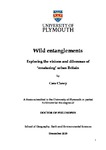Wild entanglements: exploring the visions and dilemmas of ‘renaturing’ urban Britain
| dc.contributor.supervisor | Wilson, Geoff | |
| dc.contributor.author | Clancy, Cara Louisa | |
| dc.contributor.other | School of Geography, Earth and Environmental Sciences | en_US |
| dc.date.accessioned | 2019-07-30T15:50:20Z | |
| dc.date.available | 2019-07-30T15:50:20Z | |
| dc.date.issued | 2019 | |
| dc.date.issued | 2019 | |
| dc.identifier | 10537233 | en_US |
| dc.identifier.uri | http://hdl.handle.net/10026.1/14717 | |
| dc.description.abstract |
In a rapidly urbanising world, where lands are increasingly repurposed for human endeavours, where seas and rivers carry the weight of mounting plastic, where species extinction is a common theme and where the effects of global climate change are a daily reality, there has never been a more pressing need to rethink nature-society relations and environmental ethics. This thesis draws insights from two cases of urban renaturing in Britain (London and Plymouth) to explore critical issues in contemporary environmental practice, including what matters for humans and nonhumans in such endeavours. Renaturing is here understood as an intentional, reflective attempt to restore human/nonhuman relations, as well as the biophysical health of ecosystems. The twofold nature of this endeavour makes it a productive point of investigation, offering a means to uniquely contribute to academic discussions on nature-society relations and the future purpose of nature conservation in the UK. It argues that within urban environments, renaturing is best understood as a lively and creative endeavour, yet one full of contestation, characterised by issues of power, ownership and participation. For this reason, the thesis explores renaturing from human and more-than-human perspectives, to draw out multiple voices and thereby enrich understandings of what it means to intervene in nature, especially in dynamic, multispecies cities. The two case studies offer different angles on urban renaturing. Firstly, the study reveals that contemporary ambitions for ‘wilder cities’ do not exist in a vacuum: ‘nature’ is silently structured and ordered according to urban planning agendas, as well as vivid (re)imaginations of the environmental past. Secondly, it reveals that wild spaces can become highly defended places in cities. While this is partly due to do with the perceived issue of urban encroachment (higher densities of people), it is also to do with the way nature is imagined (as vulnerable and exclusive). Thirdly, it reveals that renaturing has material consequences for all those creatures who do not ‘count’ as nature. Taking a more-than-human approach, it argues that spatial categories (native/invasive, wild/domestic) do little to meet contemporary challenges in more ethical and meaningful ways. Finally, it reveals that in post-normal and post-natural times, there are significant limitations in the way(s) that humans govern the nonhuman world, including the decision-making capabilities of such actors. It therefore argues that there is a need to rethink the ways in which nature knowledge is produced, with closer attention to place, and what place reveals about the inextricable entanglements of people, plants and the many creatures and critters that exist in UK cities. | en_US |
| dc.language.iso | en | |
| dc.publisher | University of Plymouth | |
| dc.rights | CC0 1.0 Universal | * |
| dc.rights.uri | http://creativecommons.org/publicdomain/zero/1.0/ | * |
| dc.subject | Rewilding | |
| dc.subject | More-than-human geographies | |
| dc.subject | Anthropocene | |
| dc.subject | Conservation | |
| dc.subject | Animal geography | |
| dc.subject | Urban ecology | |
| dc.subject | Human-animal studies | |
| dc.subject | Walthamstow Wetlands | |
| dc.subject | Ernesettle | |
| dc.subject | Urban geography | en_US |
| dc.subject.classification | PhD | en_US |
| dc.title | Wild entanglements: exploring the visions and dilemmas of ‘renaturing’ urban Britain | en_US |
| dc.type | Thesis | |
| plymouth.version | publishable | en_US |
| dc.identifier.doi | http://dx.doi.org/10.24382/571 | |
| dc.rights.embargoperiod | No embargo | en_US |
| dc.type.qualification | Doctorate | en_US |
| rioxxterms.version | NA |
Files in this item
This item appears in the following Collection(s)
-
01 Research Theses Main Collection
Research Theses Main



